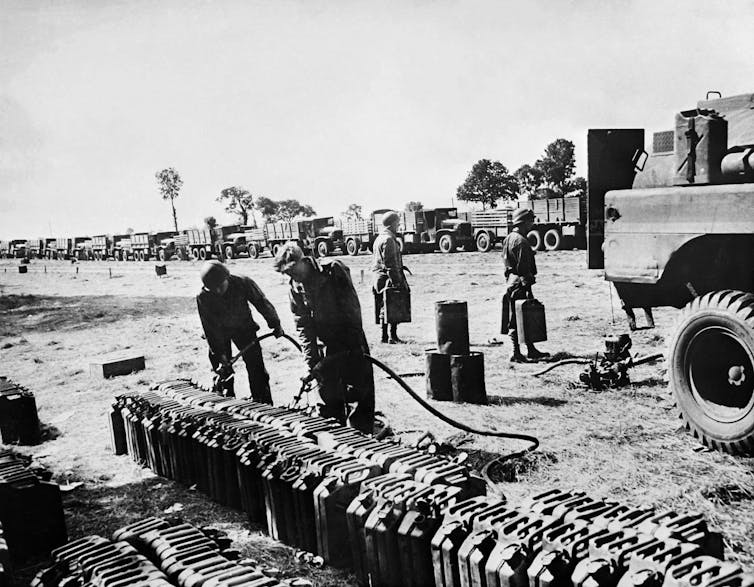by Jelani Greenidge, Urban Faith Contributing Writer | Jan 27, 2012 | Entertainment, Feature, Headline News, Jelani Greenidge |
 There’s been plenty of buzz surrounding Red Tails, the George Lucas blockbuster action picture depicting the daring exploits of the 332nd Fighter Group of World War II, more commonly known as the Tuskegee Airmen. Strictly by the numbers, it’s been considered an initial success, grossing $19 million in a strong opening weekend. Anecdotally, my Facebook and Twitter feed are both testifying to its popularity. People are talking about it.
There’s been plenty of buzz surrounding Red Tails, the George Lucas blockbuster action picture depicting the daring exploits of the 332nd Fighter Group of World War II, more commonly known as the Tuskegee Airmen. Strictly by the numbers, it’s been considered an initial success, grossing $19 million in a strong opening weekend. Anecdotally, my Facebook and Twitter feed are both testifying to its popularity. People are talking about it.
And if I were strictly a PR flack for Lucasfilm, I’d be focused primarily on trying to find out what people are saying about it.
But as a critical thinker, I have to get beyond the question, “what are people saying?” and get to the bigger question — what should people be saying?
I realize that’s an inherently presumptuous question. People are entitled to their own reactions to any piece of art or commerce. But anytime there is a popular movie or television show that captures the collective attention of a sizable group of people, most of the responses tend to be polarized. Yet, discerning viewers need to be able to give and receive more feedback than just, “it was great!” or “it sucked.”
The truth is, no matter what you thought about the film itself, there are great lessons to be learned in the wake of this Red Tails phenomenon, and we’d all be better off if we could dig deeper and find them.
Lesson one: Before we decide if it’s good or bad, let’s be grateful Red Tails was made.
I know it’s obvious, but really … this can’t be repeated enough: it is amazing that this film ever got made. George Lucas deserves a lot of credit for putting his money on the line to make this film. No disrespect to the well-done mid-’90s HBO version, but Red Tails is the kind of movie that kids and teens might actually want to see, instead of being the kind of movie that they dutifully sit through to please their parents.
When you get right down to it, Black history is American history. But this particular chapter in American history has been so overlooked for so long that it takes a film with a big budget, decent writing, excellent sound design, and other Hollywood perks to get a wider array of people to pay attention and give these heroes their due.
So whether or not Red Tails is a great film is, in my view, mostly irrelevant. It doesn’t need to be great. It just needs to be legit … to have the air and cachet and buzz of a major blockbuster motion picture. And on those grounds, it has succeeded.
Strictly as a piece of WWII-era entertainment, Red Tails is a mixed bag. It’s not as good as, say, last summer’s Captain America. As a matter of fact, I enjoyed Sky Captain and the World of Tomorrow more than I liked Red Tails, despite the fact that it flopped pretty badly at the box office.
Which just goes to show you that critics aren’t always a great indicator of what people will flock to.
No, Red Tails isn’t going to set the world on fire … but that’s fine. Neither did Pearl Harbor with Ben Affleck and Josh Hartnett. But they’re both historical films that inform our broader American culture about important people and events in our nation’s history.
And by the way, the fact that George Lucas had to put so much of his money into it to make it happen is the main reason why he’s getting all of this love. It’s not because it’s such a great movie, or because Lucas is a such a greatfilmmaker (more on that in a bit).
It’s because it’s such a great thing for the movie to have been made in the first place.
To resurrect a tired-but-appropriate illustration:
Bankrolling a Big-Budget Blockbuster With An Ensemble Cast And Top Rate Special Effects, as well as Bankrolling the Promotion and Distribution For Said Film when the Big Hollywood Studios Wouldn’t Touch It: $60 Million.
Honoring the Story of A Neglected Subset of American Heroes and Inspiring Black Boys In Ways That Other Films Have Never Done Before: Priceless.
Lesson two: Stop giving George Lucas all the credit — or blame.
Because of the cult fandom of Star Wars that played out through the ’80s and ‘90s, George Lucas developed a near mythical persona — that is, until he released the trilogy of Star Wars prequel films, and then he became a rhetorical punching bag for disillusioned fans of the original films.

FROM SKYWALKER TO TUSKEGEE AIRMEN: 'Red Tails' producer George Lucas. (Photo: Nicolas Genin/Wikipedia)
Ever since, George Lucas has had a polarizing effect on people. And depending on whom you talk to, he’s considered either a rarified genius or a no-talent hack.
Here’s what a lot of folks are forgetting, though — George Lucas did not direct Red Tails.
That honor went to Anthony Hemingway, notable for his TV work on HBO’s The Wire and Treme. And so should some of the praise — and the blame — for the way it turned out. Many of the people who automatically take aim at Lucas don’t necessarily understand the role of a producer, and how it differs from that of a director.
It probably hasn’t helped that Lucas has done all of the high-profile press and television appearances by himself. Not only might it have helped to elevate Anthony Hemingway’s profile as a young, up-and-coming African American film director, but Lucas might have more easily avoided flirting with a White savior complex.
Lesson three: It wasn’t just money that turned this idea into reality; it was also passion, humility, and relationship.
Being a historical film, Red Tails is a fun ride, but it doesn’t have too many surprises (SPOILER ALERT: the Germans lost the war.)
The biggest surprise for me about Red Tails was in the credits — that alongside main screenwriter John Ridley was none other than Aaron McGruder, creator of The Boondocks comic strip and animated series.
(*cue the sound of needle scratching record*)
Yes, this is the same Aaron McGruder who, through the voice of his protagonist Huey Freeman, took shots at George Lucas and the Star Wars prequels on a regular basis — especially for the character Jar Jar Binks, who was widely considered to be an annoying galactic caricature of Black stereotypes.
It’s no surprise that he would branch out into feature films, but seriously … raise your hand if you foresaw Aaron McGruder teaming up with the man he so thoroughly and publicly lambasted. (Now put those hands back down, and stop lying.)
The truth is, it would’ve taken a lot of humility for George Lucas to invite Aaron McGruder into the collaborative process, and just as much for McGruder to accept that invitation. But that’s also where the passion part comes into play. Both Lucas and McGruder grew up in awe of the Tuskegee Airmen, and as McGruder explains in this clip, everyone who collaborated on the film had a real desire to honor them as heroes, and tell their story the right way.
Then when you factor in Lucas’ romantic relationship with Mellody Hobson of Ariel Investments, and how that might have bolstered his sense of connection to the Black community at large, it’s clear that George Lucas did not see Red Tails as simply another commercial investment or even routine altruism. It was a labor of love with a significant emotional investment.
* * *
This is the point that Christian leaders need to really understand. So much energy is spent in dissecting all of the problems in our country … racism, poverty, political rancor, you name it. As much as we need solid cultural analysis and biblical exegesis regarding these matters, being engaged from a distance will only get us so far. What we need is leaders who can speak to these issues with the conviction and gravitas that can only come from being personally invested.
It’s no surprise, for example, that of all the high-profile White pastors and/or Christian leaders, the one who most recently released a definitive biblical exploration of the race issue in America (Bloodlines, available here as a free download) is John Piper, a man known primarily for his role as author and pastor, but who also cherishes his role as an adoptive father of an African American teenage girl. It’s one thing to pontificate in theory about how Blacks and Whites can and should live in unity. It’s another thing to try to walk that out in your own household, day by day.
And maybe that’s the biggest lesson that Christians can extract from the story of Red Tails — that in desperate times, history celebrates the ones who are willing to forego safety and security in order to bravely take on the task at hand.
And yes, there are times when the battle doesn’t belong to us. But when it does, we put on the full armor … and yes.
We fight.
We fight.












 There’s been plenty of buzz surrounding Red Tails, the George Lucas blockbuster action picture depicting the daring exploits of the
There’s been plenty of buzz surrounding Red Tails, the George Lucas blockbuster action picture depicting the daring exploits of the 